Palms for Scandinavia
Yes, it is really possible to grow palms outdoors to some extent in the milder parts of Scandinavia. There are indeed palm trees that are growing outdoors in a few places in Denmark, Norway and Sweden. It is no idea to think about high swaying palm trees in the tropics. The palms that possibly may be hardy in Scandinavia are normally rather small in size and the number of species is fairly limited. In addition, they need a certain amount of protection in the winter. The ground under the palm should at least be covered in the winter and the leaves may also need protection in cold winters. It can be quite hard to do with tree size palms but some of the hardiest species are dwarf palms that are fairly easy to protect.
There are in principle two main groups of cold hardy palms:
- Those that grow well in cool climates but need mild winters (Trachycarpus, Chamaerops).
- Those that can handle severe cold but need warm summers to grow well or to reach full winter hardiness (Rhapidophyllum, Sabal minor, Nannorrhops).
There are unfortunately no palms that can handle both cool summers and cold winters. The first group is the most interesting one for Scandinavian conditions and among that group mainly Trachycarpus.
Even though the most palms that now grow in Scandinavia are planted in the 1990´s or later, is it not a novelty. There were probably at least in Denmark palm trees that grew outdoors in the 1930´s and 1940´s. It is not likely that any palms have survived outdoors in Scandinavia more than one or a few decades. If long term survival is important then it is best to choose the hardiest varieties of the hardiest species. It is wise to be prepared to protect the palms in severe cold. The hardiness can probably be increased with the right fertilization.
The picture below is from the Botanic Garden in Copenhagen. It gives an idea about what is possible to grow even in the milder parts of southern Sweden.
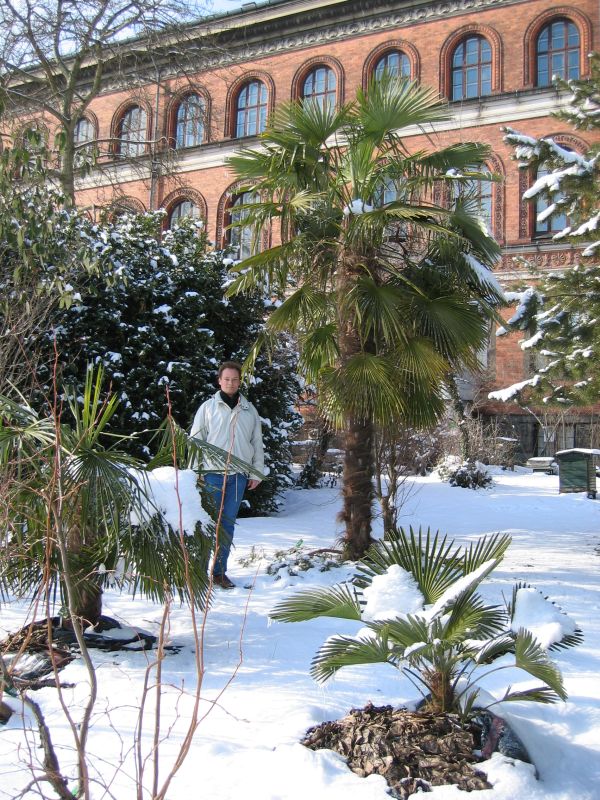
Trachycarpus fortunei (Windmill Palm) in the Botanic Garden in Copenhagen, March 2006 (the large palm was planted in 1988). In the foreground a small T. wagnerianus can be seen. Leif Klingström (190 centimetres tall) stands next to it as a size reference. Click to see how it looked like in January 1996, October 2003 or in February 2005.
Trachycarpus
The palm species that is best known for being cold hardy is Trachycarpus fortunei (Windmill Palm) from China and Japan. It is not the most cold hardy species but it is fairly fast growing and one of the few hardy species that will reach tree size. It is also relatively cheap and easy to find (not in Scandinavia). It is a rather tough palm that has a good ability to recover also from severe leaf damage. It is however sensitive to wind. It will handle temperatures down to −10°C fairly well and older established specimens in good condition are likely to handle temperatures down to −15°C without any major damage to the leaves. The leaves may be destroyed by lower temperatures and temperatures about −20°C or lower may be lethal for the palm. Even prolonged cold periods at more moderate temperatures could kill this palm. Despite this, there are reports about Trachycarpus palms that have survived temperatures to −25°C or even lower (see below).
Trachycarpus fortunei should be able to thrive on the Norwegian west coast and into the Norwegian fiords. It should also do fairly well in many coastal regions in Denmark. The possibilities for T. fortunei are more limited in Sweden, but it should be worth testing along the Sound coast in Skåne and favoured locations along the Swedish west coast and maybe also some places in Blekinge och Öland. The climate is often much milder in big cities and T. fortunei should be worth testing in, for instance, protected backyards.
Western Norway is the most northern area in the world where palms can grow outdoors all year round. Exactly how far north they can grow is hard to estimate since there is no sharp climate boundary.
To judge whether Trachycarpus fortunei can grow on a certain place, the other plants that will grow there can be studied. Suitable indicator plants are e.g. Araucaria araucana and Ficus carica (fig tree). Araucaria araucana is unfortunately quite rare as an ornamental plant in Scandinavia so Ficus carica is in practice a better indicator plant. It is also important to know that A. araucana is slightly hardier than both T. fortunei and F. carica, which could create false security. In a climate where F. carica can grow up to a big bush or a small tree will T. fortunei probably also do well most winters without any other protection than ground cover. If F. carica regularly freezes then should also T. fortunei have more extensive protection. If F. carica cannot grow outdoors at all then T. fortunei will be out of question. In several places in Denmark there are 4–5 metres high specimens of F. carica that fruits every year. In these places should T. fortunei also perform quite well. There will of course be single winters when F. carica may freeze even in these places and then will T. fortunei also require more protection.
A characteristic feature of Trachycarpus fortunei, as of a few other Trachycarpus species, is the shaggy trunk. The trunk is covered by fibres from old leaf bases that are persistent. This occurs also in some other palm genera but is rarely as obvious as by T. fortunei. It gives an impression of a "wooly-haired" palm tree. Even though these palms are quite hardy by themselves, it is quite likely that the fibres can increase their survival chances during cold winters. Palms are of course ectothermic but the fibres can contribute to even out temperature variations. It is possible to peel off the fibres, which will give the palms a more exotic appearance, but considering the harsh climate in Scandinavia, it will be better to leave the fibres on the trunk.
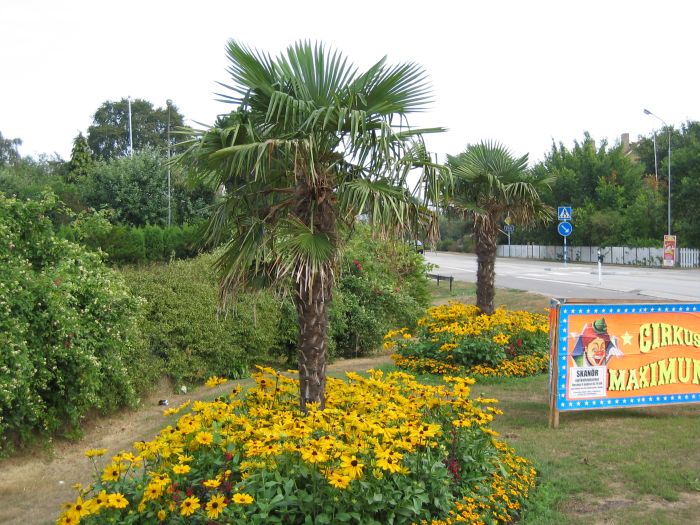
Trachycarpus fortunei in Skanör, Sweden, summer 2006, planted 1999). They don't seem to be much protected in the winter, but do quite well since Skanör has one of the most favourable climates in Sweden. Skanör is located on a peninsula on the southwesternmost tip of Sweden.
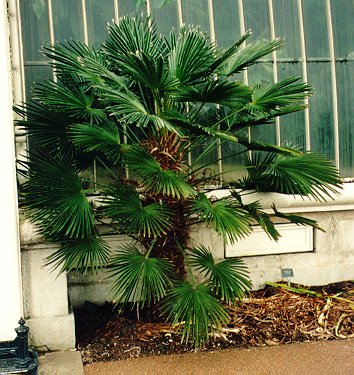
Trachycarpus wagnerianus in Kew Gardens, London 1997.
Another quite attractive species is Trachycarpus wagnerianus. The exact origin of this palm is unknown but it seems to have originated in cultivation in Japan or Korea. It is now officially regarded as just a variety of T. fortunei and should correctly be called T. fortunei var. wagnerianus. It has smaller and stiffer leaves than T. fortunei and this is particularly evident with young plants. The hardiness is about the same as that of T. fortunei but the wind resistance is better. Here is a picture of T. wagnerianus and T. fortunei together where the appearance can be compared. The fact that this variety deserves to not to be mixed up with ordinary T. fortunei in the trade can motivate that T. wagnerianus still should be treated as a species of its own. A similar variety is T. takaghii from Japan. It is often considered to be a hybrid between T. wagnerianus and the normal T. fortunei.
Trachycarpus takil is a species from northern India and Nepal in the Himalayas, which there has been a lot of hype around in recent years. It is quite similar to T. fortunei but is often regarded as slightly hardier. Unfortunately, it is quite possible that the seeds and plants that have been sold under the name T. takil in recent years in reality originates from ordinary T. fortuneis that happen to grow in the same region as the true T. takil. They may possibly belong to a new species, which in that case must be very close to T. fortunei. This type is now often referred to as T. 'Naini Tal' to seperate it from the real T. takil. Whatever these palms are, they are at least as hardy as the ordinary T. fortunei and some people believe that they are even slightly hardier. It is possible that the true T. takil could turn out to be a less hardy species. The last word is probably not yet said about this species but it will hopefully get clearer eventually. T. wagnerianus was earlier sometimes called T. takil in the USA, which contributed further to the confusion.
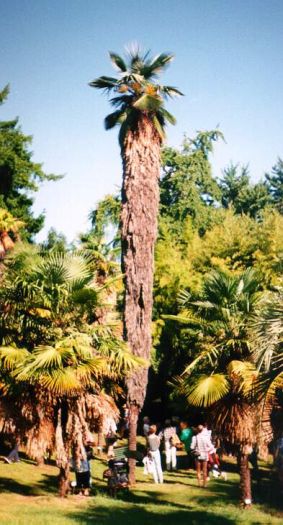
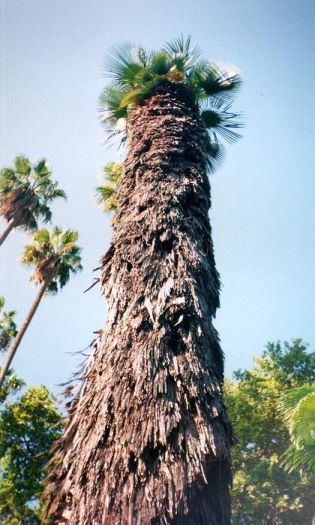
A true Trachycarpus takil in the Botanic Garden in Rome 1996. This specimen was a gift from the Italian botanist Odoardo Beccari, who described this species, and could be the only guaranteed true T. takil in the west. There used to be another specimen in Beccari´s own garden in Florence, but it was killed in the frigid winter of 1985. However, according to some people, that particular palm was in fact a Washingtonia and there are still a few T. takil left in the garden.
A very beautiful and relatively newly discovered species from southwestern China, which probably also is quite hardy, is Trachycarpus princeps. It has silver white waxy undersides of the leaves and is often considered as the most beautiful Trachycarpus species. The exact hardiness is unknown but trials in the ground in Germany suggest that it could be as hardy as T. fortunei. Some of the seeds of this species that have been sold in recent years have resulted in totally green plants. Whether these plants really are T. princeps is unclear. They are now often sold under preliminary names as T. 'Green Princeps', T. sp. 'Nova' and T. sp. 'Nu Jiang'.
Another newly discovered and recently scientifically described species is Trachycarpus ukhrulensis from the Manipur region in northeastern India. It is sometimes also called T. sp. 'Manipur' or T. sp. 'Naga Hills'. It has white waxy undersides of the leaves in the same way as T. princeps. It has shown some cold tolerance but it is still unclear exactly how hardy it might be.
Yet another recently discovered and possibly hardy species is Trachycarpus geminisectus from northern Vietnam. It distinguish itself by that the leaf segments are joined in groups of two or sometimes three. Also this species have white waxy undersides of the leaves.
There is at last a dwarf species, Trachycarpus nanus, from China which could be slightly hardier than its tree size relatives. Unfortunately, it grows extremely slowly, which makes it hard for it to recover from winter damage. However, its limited size makes it easy to protect in the winter.
All the Trachycarpus species mentioned above have, as the species T. oreophilus, in common that they have kidney shaped seeds. There is another group of Trachycarpus species that have oval seeds instead. The best known of these is T. martianus. Another relatively recently discovered and related species is T. latisectus. This latter group have in common that they are in general less hardy than the species with kidney shaped seeds. None of these can probably grow in Scandinavia, at least not without winter protection.
It can be argued which one of the Trachycarpus species that really is the hardiest. T. takil was for a long time considered as a good candidate. In its natural habitat, it grows in mountain areas in western Nepal and adjacent areas to the west in India at altitudes up to 2500 metres above sea level. However, the climate is probably not that cold in its natural habitat. There are probably local variants of T. fortunei that could be even hardier. T. fortunei is a widely distributed species in China and Japan and grows at least in cultivated form in areas with a January mean temperature slightly below the freezing point. In addition, it has naturalised in several rather cold areas.
There are Trachycarpus palms growing in the city of Plovdiv in Bulgaria that are supposed to have survived temperatures down to −28°C at several occasions (see The Polar Palms of Bulgaria). The air is normally very dry when the severest temperatures occur, which certainly will help the palms handle the cold but this is not enough to explain why these palms can stand such extreme cold. There are also reasons to believe that these palms probably never have been exposed to temperatures as low as −28°C. The palm trees grow on a hill in central Plovdiv whereas the extreme temperatures probably are recorded on an airport outside the city. It is however possible that these palms may belong to a slightly hardier variety and should in that case be interesting for Scandinavian conditions. Even in that case, they are not likely to show the same hardiness in Scandinavia but it may still be enough so that they can be regarded as fairly reliably hardy even without protection in the milder areas. When plants that originates from the Bulgarian palms have been tested in other countries they have not differed much in hardiness from other types of T. fortunei.
The Lady Palm, Rhapis excelsa, was originally described as Chamaerops excelsa. When Trachycarpus fortunei was introduced to Europe, it was thought to be this Chamaerops excelsa. This name is also still used as a synonym for T. fortunei in some European countries, like Italy and Spain. T. fortunei is otherwise often called "Chusan Palm" since the botanist Robert Fortune first encountered this palm on the island Zhoushan off of the Chinese east coast. Later, another species was described; Chamaerops fortunei. These palms were then later placed in a new genus; Trachycarpus. Both names, Trachycarpus fortunei and T. excelsa lived on in parallell until they were eventually identified as the same species and T. fortunei became the valid name. Still, the name T. excelsa has lived on and it has been thought that there are small differences between the typical T. fortunei and T. fortunei 'Excelsa'. The latter is thought to have straighter and stiffer leaves. There is indeed a lot of variation within the species of T. fortunei. T. fortunei var. wagnerianus is an extreme example of this. However, rather much of the variation is caused by the growing conditions like the amount of light, water and nutrients. A palm can change its appearance when the growing conditions change. There can certainly be as much variation in hardiness as in appearance but also this depends on the growing conditions.
Rhapidophyllum hystrix
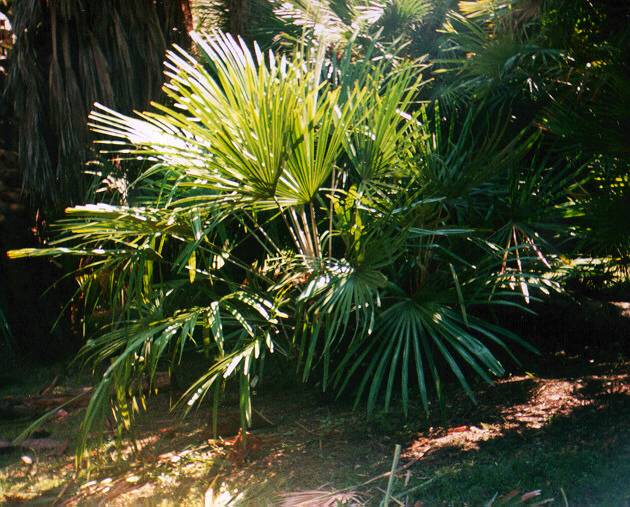
Rhapidophyllum hystrix in the Botanic Garden in Rome 1996.
Rhapidophyllum hystrix (Needle palm), the only species in the genus, from southeastern Unites States, is often regarded as the most cold hardy palm species. Unfortunately it is just a dwarf palm that grows very slowly in our climate but it is at least quite easy to protect in the winter. It is regarded as hardy down to −20°C and there are reports about that it has survived temperatures of −26°C. This is a very suitable palm for climates with warm summers. It will thrive up to Massachusetts in the eastern United States. Here you can find pictures of Rhapidophyllum in National Arboretum, Washington DC.
Rhapidophyllum is best suited for the areas in Scandinavia that have the warmest summers, e.g. southeastern Denmark and mild areas in southern Sweden up to the Stockholm region. Since Scandinavia cannot offer any warm summers, the warmest and sunniest location should be chosen. The speed of growth may possibly be increased with the right fertilization. It should be planted next to a warm and sunny southern wall. The bigger plant the better. Large plants are unfortunately quite expensive since the species is hard to propagate and is slow growing.
Since Rhapidophyllum does not grow very well in Scandinavia is it uncertain if it is really worth to plant outdoors. Trachycarpus is in most cases preferable to Rhapidophyllum.
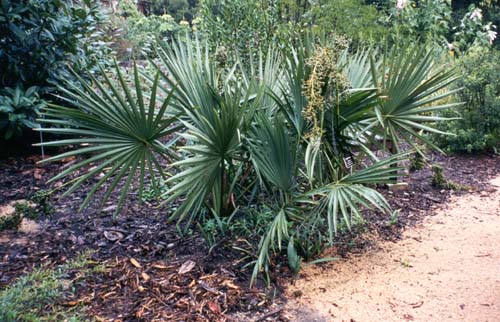
Sabal minor in the Botanic Garden in Chapel Hill, NC 1999.
Sabal minor
Sabal minor, a normally trunkless dwarf species from southeastern United States, is likely to be the only species from the genus that may be interesting for Scandinavia. Even though there are other rather cold hardy species of Sabal, they are not hardy ehough for our climate. S. minor grows over a quite large area but it is mainly the varieties that grow inland in Oklahoma and Arkansas that are really hardy (see Oklahoma's Native Sabal minor). These varieties may possibly compete with Rhapidophyllum in hardiness. Its ability to survive low temperatures perhaps depends on the fact that the trunk is protected below ground since the leaves are not extremely hardy. Unfortunately, it grows very slowly and needs much summer heat like Rhapidophyllum. It is difficult to indicate a precise hardiness because it depends a lot on how hot the summers are. All Sabal species have very sensitive roots that can easily die if they are damaged. They therefore need plenty of time to become established after planting.
Sabal × brazoriensis (syn. S. × texensis) has in recent years got a reputation of good cold hardiness. It also grows faster than many other species of the genus Sabal. In nature, it grows in a small area in Brazoria Co. south of Houston, Texas. It is often considered as a natural hybrid between S. minor and a trunk-forming species where S. mexicana (syn. S. texana) is a possible candidate but where S. palmetto is more likely. Although it resembles S. minor, it grows larger and may, over time, develop a real trunk. There is probably no experience yet of growing this palm in Scandinavia. Our summer heat is most likely not enough.
Nannorrhops ritchiana
Nannorrhops ritchiana (Mazari palm) is a unique and peculiar dwarf palm, that grows in dry areas from Saudi Arabia to Pakistan. At least some varieties are very cold hardy and can compete with Rhapidophyllum in hardiness. It it said to grow in mountain areas in Afghanistan where it can be covered by snow for longer periods in the winter. All varieties are not equally hardy. The variety from Afghanistan is unfortunately not available in the market. Varieties from Iran could also be hardier and may become available in the market.
Even if it is a very cold hardy palm, is it unfortunately very sensitive to humid and wet conditions in the winter. It should be planted on a dry place, preferably close to a house wall, and needs warm summers like Rhapidophyllum. No Mazari palm has probably been able to survive a winter in the ground in Scandinavia.
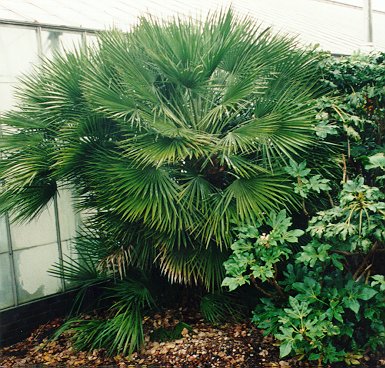
Chamaerops humilis in Kew Gardens, London, October 1997.
Chamaerops humilis
Also Chamaerops humilis (European dwarf palm) deserves to be mentioned. It may not be one of the most hardy species but it is fairly easy to protect in the winter. The soil should be rather dry in the winter in order to reach full hardiness. Here is a picture of a Chamaerops humilis in the wild outside Almuñécar in southern Spain. Chamaerops humilis var. cerifera from the Atlas mountains in Morocco is considered as slightly hardier than the species.
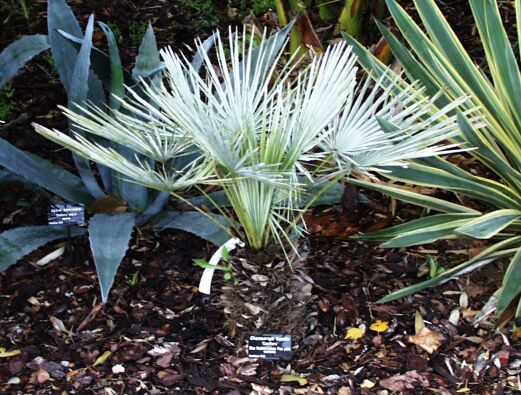
Chamaerops humilis var. cerifera at The Palm Centre outside London october 2000.
Trithrinax campestris
Trithrinax campestris comes from Argentina and Uruguay and has short and very stiff grey-green leaves. It forms multiple trunks and is somewhat reminiscent of Chamaerops humilis but can not exactly be called a dwarf palm tree, even though the trunk never grows very high. It is said to withstand down to −15°C but needs to be protected from precipitation in the winter. It grows slowly and appreciates high summer temperatures.
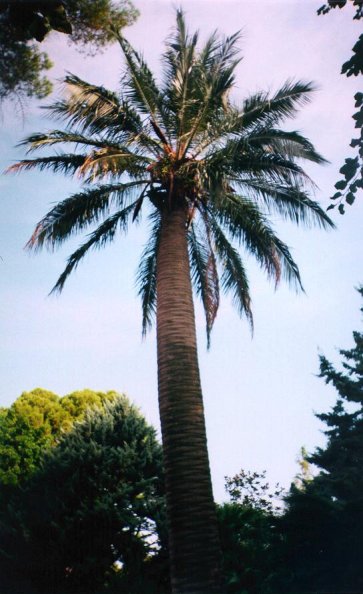
Jubaea chilensis in Rome 1997.
Jubaea chilensis
Jubaea chilensis (Chilean wine palm) is perhaps the only palm with feather shaped leaves that possibly might be hardy without artificial heating during the winter in the very mildest parts of Scandinavia. It is a very impressive palm, which in course of time can grow very large and, above all, it has an extremely massive trunk. Historically, the sap of this palm has been collected to produce palm honey or fermented into an alcoholic beverage but unfortunately, this required that the palm was cut down. Despite its hardiness, Jubaea is in fact related to the Coconut palm, Cocos nucifera, which of course is cold sensitive and require a genuine tropical climate. The fruits of this palm, coquitos, are edible and do actually taste like coconuts.
Jubaea does not require warm summers but does unfortunately grow very slowly. It is considered to be hardy down to −15°C and there are rumours that it could have survived −20°C. Even though this species sometimes is considered to be almost as hardy as Trachycarpus fortunei, it will not recover from heavy winter damage as fast, since it grows much slower.
In Scandinavia is it probably only interesting for the mildest areas of southwestern Norway. It could also be worth trying in the mildest areas of Denmark. It may be possible to grow in somewhat colder areas when it still is small and can be protected in the winter.
Jubaea chilensis is unfortunately very expensive and grows very slowly, at least before it has developed a trunk, which may take several years.
Butia
The South American genus Butia consists of nine species that all show some cold tolerance but are slightly less hardy than the related species Jubaea chilensis. The most well-known species is Butia capitata. Plants sold under the non-accepted name B. bonnetii are thought to be hardier. B. bonnetii is often considered as a synonym for B. capitata var. odorata, which grows in slightly colder areas in nature. Also B. eriospatha has a reputation of being hardier and is possibly the hardiest species.
A Butia yatay was planted in the ground in the Botanic Garden of Copenhagen in the summer of 2006. It has survived its first winter in the ground without any damage despite minimal protection with only ground covering. However, it was a very mild winter and the palm will require more protection and perhaps artificial heating in colder winters.
Growing palms in the ground.
Planting
At least Trachycarpus should be planted in well drained, neutral to light acid soil. Since a good drainage could strengthen the cold resistance, it can be good to plant the palm in a raised bed. The bed should be large enough so the frost cannot reach the roots from the sides.
It is often good to plant the palm in the ground when it has started to develop a real trunk with full diameter. However, it is possible to plant them when they are young provided that they are protected in the winter. It is also easier to protect small plants. In fact, even seedlings of Trachycarpus are surprisingly hardy and will survive the winters in very mild areas. If you can afford it, you can plant a lot of seedlings in the ground or even germinate the seeds in the ground and then let the winter cold select the hardiest seedlings. Of course, if you are unlucky, you could lose all seedlings. It is of course possible to protect the seedlings a bit.
The best time to plant palms is in spring or early summer. Palms should not be planted in late summer or autumn. They should get a chance to establish themselves in the ground before the winter. It is not uncommon that they will stop growing or grow very slowly the first year in the ground. The roots will grow at least.
Winter protection
It will probably be enough to cover the ground below a Trachycarpus in the mildest areas of Scandinavia. Also the leaves may need protection in cold winters or in colder areas. However, it is important that the cover is not too tight, otherwise there will be condensation. The leaves will handle lower temperatures in dry air. If it is damp within the cover, the damage may become much worse than without any protection at all. Here is a picture of frost damage on the leaves that partly have grown worse because of a too tight cover. Plastic covering is rather unsuitable as protection but despite this, people often use bubble wrap to protect palms. It does give good temperature insulation but could be dangerous. It will probably work well with artificial heating.
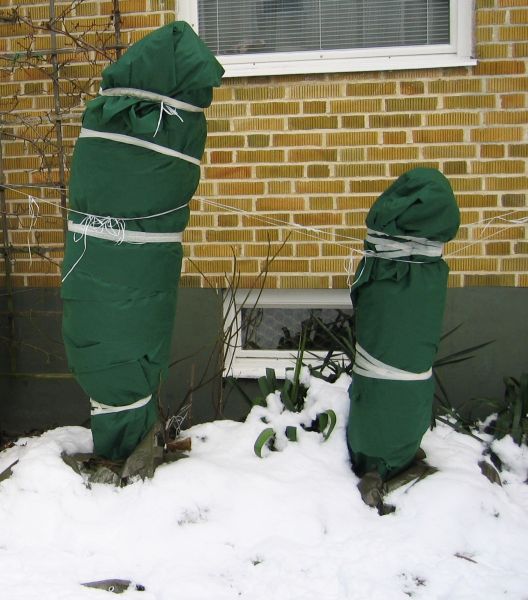
Trachycarpus fortunei and T. wagnerianus with winter protection, winter 2005. (planted in 1992 and 1998) Click here to see how they looked like later in the summer 2005.
One way to protect the leaves that probably works well is to tie them up and wrap them in horticultural fleece. Thick green or brown types of horticultural fleece are better than the more common thin white type. The reason for this is that a dark fabric absorbs more sun heat, which contributes to drive out humidity from the protection. Fortunately, Trachycarpus does not seem to be damaged by being kept in total darkness for several months during the coldest part of the year. The horticultural fleece should be folded in a way that will prevent water from entering the protection. Leaf damage could occur even with a protection like this but most of the damage will appear where the leaves are in contact with the fabric. In order to avoid this, after the leaves have been be tied up, a framework of sticks can be built around the palm and the horticultural fleece is wrapped around this. In this way, a "tent" is created where the leaves cannot touch the fabric. However, this protection must be stable and be able to stand strong winds and for that reason, it is wise to secure it properly with strings or wires.
Besides normal horticultural fleece sheets, there are now also large plant jackets sewn from horticultural fleece. They have zippers on the side so that they easily can be opened. For tall palm trees, these are much easier to handle than regular horticultural fleece sheets to protect the crown. It is appropriate to tie a pole next to the stem with a round screen attached to the top so that it protects the palm's crown. Then it will be easy to hang a fleece plant jacket on top of the screen. The purpose of the screen are that it will be drier and more airy around the leaves, but above all to avoid to weigh down the crown, which is important when it snows. The screen should be designed so that it can not tear the fleece plant jacket and should for that reason not have any sharp edges. At the same time it must also be strong and stable. A popular solution is to use a lid from a water barrel as a screen and mount it on a pole. Anything of similar size and shape will do. Fleece plant jackets have previously only been available outside Scandinavia but have more recently become available also in Sweden and Denmark.
It can be beneficial to protect the ground from precipitation since palms tolerate cold better in relatively dry air and soil. The ground can be kept relatively dry if a piece of tarpaulin or other waterproof cover is cut in a way that will fit around the palm and dry leaves, twigs or other materials is stuffed under it in a way that will make water run away from the palm.
Small specimens of Trachycarpus are not as hardy and need protection most winters. An appropriate way to protect small palm is to build a "cage" of e.g. chicken wire that is filled with dry leaves and that is protected from precipitation. It is wise to have additional dry leaves stored to exchange the leaves if they have become wet.
Rhapidophyllum does not need as much protection as Trachycarpus. It is however wise to cover the ground around the palm and also protect the leaves from precipitation since it can cause ugly spots on the leaves. Even though Rhapidophyllum is very hardy, it easily develops bud rot, which could be lethal. It is at least common that the developing spear is damaged.
It is important to be observant so that it will not get too warm inside the cover on sunny days. Trachycarpus does not need any high temperatures to start growing. The new growth is more sensitive to cold and can easily be damaged by cold weather after a mild period. Even if these injuries are not too extensive from the start they may cause rot in the developing leaves and in the end, rot in the bud itself, which may kill the palm.
In colder regions or during really cold winters in milder areas, winter protection need to be supplemented with some form of heating. With heating it is possible to grow also more sensitive species like Jubaea chilensis. A method that is inexpensive and seems to be popular right now is to wrap the palm tree with Christmas lights, especially rope lights, for outdoor use. Rope lights consist of a bunch of tiny incandescent light bulbs that are inserted into a flexible plastic tube. Incandescent light bulbs will eventually be removed from the market for environmental reasons because they have poor efficiency. In this case, it is precisely the poor efficiency that is desired. Rope lights with LEDs instead of light bulbs have already appeared on the market, so you have to watch out when you purchase a rope light for heating. The total effect of a rope light is often around 100 W.
Rope lights have no form of power regulation, and generate the same power all the time when they are lit. A rope light must be handled with care and should not be wrapped too tightly. It is important to spread out the rope light so it does not get too hot in any single point. There are rumours that people have managed to set their palms on fire in their attempts to warm them with Christmas lights. In order to spread out the heat, chicken wire can be wrapped closest to the trunk. The heat should only be on when it gets really cold and should definitely be avoided if the temperature rises above freezing. The idea is that the palm should not be warm, just to avoid too low temperatures. The temperature also depends on how much you insulate outside the rope light. It will of course be warmer if you sweep several layers of horticultural fleece or bubble wrap around the light rope. It can be a good idea to place a temperature sensor for an electronic thermometer inside cover so you can monitor the temperature and adjust the rope light or cover. For Trachycarpus, it will be appropriate to turn on the light tube when the temperature drops below −5°C to −10°C. The easiest would be to do it manually, but it requires that the current outdoor temperature is monitored and that it is possible to turn on or off the rope light whenever necessary. A better alternative is obviously to let a thermostat control the rope light. The problem is that thermostats that work down to −10°C are rare and usually expensive. An alternative to rope lights is to use the heating cables for water pipes. These should be self-regulating but could possibly become too warm because they are designed to prevent water pipes from freezing.
Fertilization
Palms will grow faster and can probably obtain better winter hardiness if they are fertilized the right way. Even if palms do not grow the same way as other woody plants should nitrogen rich fertilizers be avoided after midsummer in order to prevent growth too late in the season which would deteriorate the cold hardiness. On the other hand is it good to supply other nutritive substances such as phosphorus and potassium also later in the season. Other substances that palms need are magnesium, iron and manganese. Especially potassium and magnesium are important for the cold hardiness. If potassium is added, then magnesium should also be added. There is actually rarely a shortage of magnesium in the soil, but potassium supplementation will make it harder for plants to take up magnesium and therefore they should be given an excess of magnesium. For the professional grower there are products like Patentkali and Kalimagnesia containing both potassium sulphate and magnesium sulphate. For optimal effect, potassium should be added at the same time as nitrogen fertilizer, which is in early summer. It's probably nothing wrong with adding potassium even in late summer, but the effect will not be as great since nitrogen fertilizer should be avoided. In addition, it is wise to be cautious with the use of lime. Trachycarpus is not really lime sensitive but lime will make it harder for plants in general to absorb some substances such as manganese. Manganese deficiency can manifest itself in many ways but often with deformed leaves.
Frost damage primarily occur on older leaves, at least on Trachycarpus. It seems like the palm is concentrating on protecting the newest leaves, which is a quite good strategy. The palm probably reallocates nutritive substances from the older leaves to the newer. The hardiness of the older leaves will perhaps increase if the palm is well fed.
For more information about fertilization of palms, see Palm Nutrition Guide.
Links
The garden centres or seed companies below sell all the palm species mentioned above by mail-order. No particular permits are required to order within the European Union.
The old and reliable are:
- The Palm Centre
- Palme Per Paket
- rarepalmseeds.com (large selections of palm seeds, a cooperation between the palm nurseries above)
The following Scandinavian nurseries sell hardy palms:
- Drakenius Gardens
- Egnérs Prydnadsväxter
- Palmkungen
- Palmeriet (Danish nursery which is specialized in palms)
- Florentsia (seeds and plants of exotic plants)
- Frilandspalmer (palms raised outdoors in Denmark)
- ItalianGardens (Danish importer of Mediterranean plants)
- Välaplantor (outside Helsingborg, Sweden)
- www.eltong.dk (Danish seed company)
- WWW.PalmeriDanmark.dk
- Palm Center
- Mölnlycke Gardencenter (Swedish Garden Centre with many palms and exotic plants)
A lot of new nurseries that sell cold hardy palms in Central Europe have appeared in the last years. Here is a small selection of links to European nurseries and seed companies that sell cold hardy palm species:
- Tropengarten (German nursery and seed company that sells cold hardy exotic plants)
- Flora Toskana, die Pflanzenwelt des Südens
- Europalms - Cold Hardy Palms and Seeds
- Tropical Centre
- Mulu Nurseries - exotic plants
- Palmengarten
Accessories for winter protection of plants:
Other Scandinavian links about exotic plants:
- Flor & Fjære (Garden with palms in Norway.)
- Scanpalm - Palms in Scandinavia
- PALMEØYA STORD
- Cultivating palms on the edge
- Discussion board: Exotiska växter i Skandinavien (Scandinavian board about exotic plants on this server)
Other links:
- GardenPalms: Major Madden's Trachycarpus takil at the roof of the world
- The Polar Palms of Bulgaria
- Palms in Hungary
- Growing Hardy Palms
- The Hardiest Palms
- The Hardiest Palm
- Hardy Tropicals UK
- Exotic Gardening in the Netherlands
- The Cool Tropics
- Hardy Palms in Rhode Island
- The European Palm Society
- The International Palm Society
- The Pacific Northwest Palm and Exotic Plant Society
- Virtual Palm Encyclopedia
- Why Not Palms! (PDF file)
- The Southeastern Palm Society & Subtropical Plants
- Oklahoma's Native Palm "Trees" (much about Sabal minor)
- Palm Nutrition Guide
- Discussion board: Hardy Palm & Subtropical Board
- Diskussionsforum: Hardy Palms and More for the Northeast
- Discussion board: Northwest Palms
- Discussion board: Exoten und Garten (in German)
- Discussion board: Palmenforum.de (board at Palme Per Paket, in German)
- Discussion board: Palmen & Co. (in German)
- Discussion board: International Palm Society PalmTalk Forum
If you have any comments or suggestions, e-mail me:
